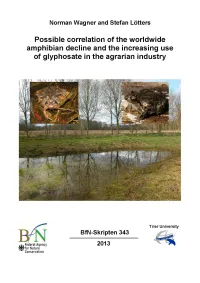BfN Schriften 343 - Possible correlation of the worldwide amphibian decline and the increasing use of glyphosate in the agrarian industry


Description
We here reviewed literature and databases on the basis of following key questions:
(i) Which concentrations of GLY and its main metabolite aminomethylphosphonic acid (AMPA) can be found in the environment?
(ii) What do we actually know about the impacts of GLY and its formulations on amphibians?
(iii) Can there be identified effects on amphibians as a result of the use of GLY coupled with biotic or abiotic stressors?
(iv) What are possible exposure pathways to different amphibian life-stages?
(v) Are amphibians differently affected by the cultivation of conventional crops compared with the HR crops especially with respect to different weed management systems?
Furthermore, we conducted a statistical, macroecological approach concerning the questions:
(vi) Do the agricultural change in the Americas and the resulting increased use of GLY correspond with amphibian population decline?
(vii) Are there as yet any 'signs' for negative impacts on amphibian populations in Germany as a result of an increased deployment of GLY in conventional agriculture?